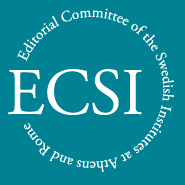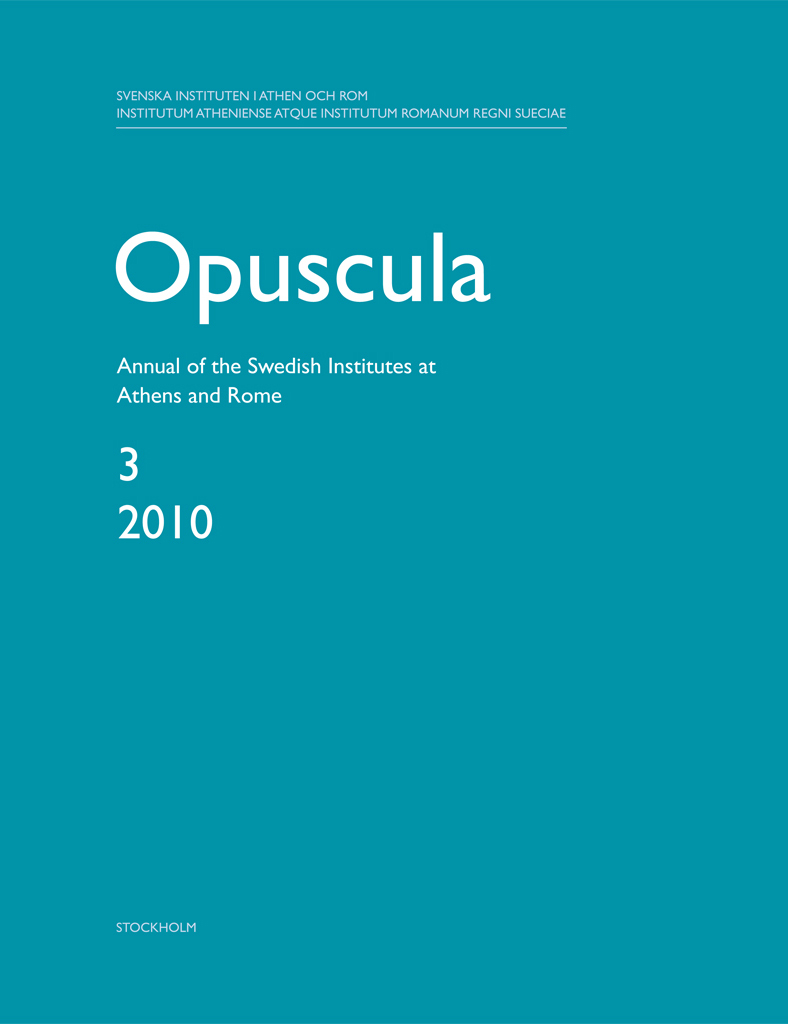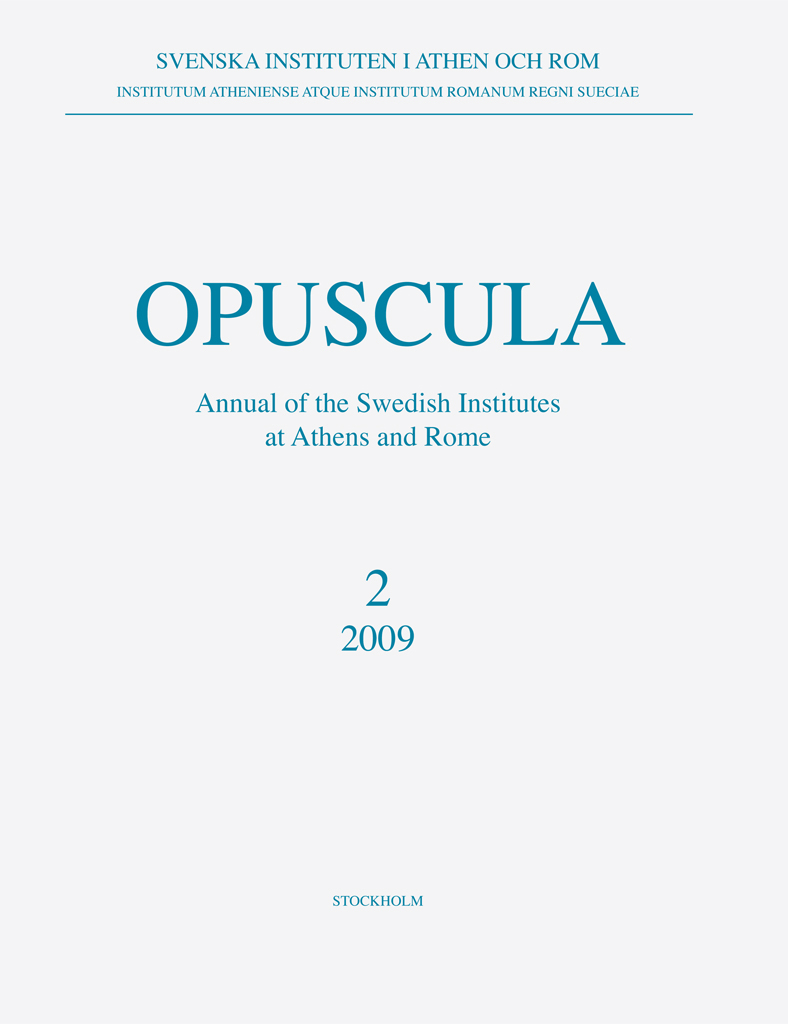Opuscula is published by the Swedish Institutes at Athens and Rome, with the aid of a grant from the Swedish Research Council. Distributed by Eddy.se AB. View journal at ERIH PLUS. Content available with open access. The bronze headbands of prehistoric Lofkënd and their Aegean and Balkan connections By John K. Papadopoulos Abstract This paper begins with an overview of the bronze headbands from the prehistoric (Late Bronze to Early Iron Age) burial tumulus of Lofkënd in Albania, which were found among the richest tombs of the cemetery, all of them of young females or children. It is argued that these individuals represent a class of the special dead, those who have not attained a critical rite de passage: marriage. In their funerary attire these individuals go to the grave as brides, married to death. The significance of the Lofkënd headbands is reviewed, as is their shape and decoration, but it is their context that contributes to a better understanding of Aegean examples, including the many bronze, gold, and silver headbands found in tombs from the Early Bronze Age through the Early Iron Age, as well as those dedicated as votive offerings in sanctuaries. In addition to discussing the evidence…
Opuscula is published by the Swedish Institutes at Athens and Rome, with the aid of a grant from the Swedish Research Council. Distributed by Eddy.se AB. View journal at ERIH PLUS. Content available with open access. Excavations in Midea 2008–2009 By Katie Demakopoulou, Nicoletta Divari-Valakou, Maria Lowe Fri, Madeleine Miller, Monica Nilsson & Ann-Louise Schallin Abstract Excavations in Midea continued in 2008 and 2009 as a Greek-Swedish programme under the direction of Dr Katie Demakopoulou in collaboration with Dr Ann-Louise Schallin. On the lower west terrace of the Acropolis excavation continued in Trench C in order to conclude the investigation of the syrinx discovered in 2007. A small trench was opened in the interior of Room I to examine the deposit below its floor. Furthermore, the cleaning of a large area outside the north section of the citadel wall brought to light a large part of a massive terrace wall. Investigations were made in three adjacent locations in the area east of the East Gate: in the baulk between Trenches 3 and 9, in Trench 9S and in Trench 12. As a result of these excavations new walls were discovered, which add to our previous knowledge of the layout of…
Opuscula is published by the Swedish Institutes at Athens and Rome, with the aid of a grant from the Swedish Research Council. Distributed by Eddy.se AB. View journal at ERIH PLUS. All content available with open access. In memoriam: Berit Wells 1943–2009. Her work at the Swedish Institute at Athens By Ann-Louise Schallin This contribution is only available in print. Bibliographical information Ann-Louise Schallin, ‘In memoriam: Berit Wells 1943–2009. Her work at the Swedish Institute at Athens’, Opuscula. Annual of the Swedish Institutes at Athens and Rome (OpAthRom) 2, 219–220. Stockholm 2009. ISSN: 2000-0898. ISBN: 978-91-977798-1-4. Softcover, 232 pages. https://doi.org/10.30549/opathrom-02-12
Opuscula is published by the Swedish Institutes at Athens and Rome, with the aid of a grant from the Swedish Research Council. Distributed by Eddy.se AB. View journal at ERIH PLUS. All content available with open access. Decorative effects and room functions. The evidence of thresholds studied in the residential quarters of Insula V 1, Pompeii By Thomas Staub Abstract The present paper discusses the use of different types of thresholds in the Pompeian domestic architecture. The considerations proceed from observations made in three larger dwellings in Insula V 1 in Pompeii, the town quarter, which is under current investigation by the Swedish Pompeii Project. The thresholds are considered in the contexts of corresponding pavements and wall decorations as well as that of the related rooms. Differences will be studied between the areas around the atria and the zones around the peristyles. They indicate that while the thresholds around the atrium are of a homogeneous character, defined by the shape and decorations of the central room, the ones around the peristyle are defined by the decorations and dignity of each particular room opening up towards the central entity. It seems also that both the material used and the shape of…
Opuscula is published by the Swedish Institutes at Athens and Rome, with the aid of a grant from the Swedish Research Council. Distributed by Eddy.se AB. View journal at ERIH PLUS. All content available with open access. The Brygos painter at San Giovenale By Yvonne Backe-Forsberg Abstract Based on stylistic criteria, it is argued in the following article that two Attic red-figured cups, one fragmentary kylix called the Pietrisco cup found in the Etruscan Bridge complex and the other one from a chamber tomb at San Giovenale, were made by the Brygos painter or a member of his circle c. 490–480 BC. The Pietrisco cup may even have been produced by Brygos the potter as it belongs to the cone-foot class. This group was previously dated to 480–475 BC, but is now backdated to 490–475 due to the analysis of the painting on the tondo of the Pietrisco cup. The Pietrisco cup was found with a substantial amount of Attic Black-figured, Red-figured and Blackglazed fragments in a fill deposit in a quadrant building of tufa ashlars interpreted as a sacellum near the Etruscan bridge at the Pietrisco brook in San Giovenale, Etruria. The two cups are the third and fourth…
Opuscula is published by the Swedish Institutes at Athens and Rome, with the aid of a grant from the Swedish Research Council. Distributed by Eddy.se AB. View journal at ERIH PLUS. All content available with open access. Zersägte Köpfe. Die Transformation antiker Porträts zu monumentalen Gemmenbildern im 18. Jahrhundert By Dagmar Grassinger Abstract Im 18. Jahrhundert wurden fragmentiert erhaltene antike Porträtköpfe bisweilen in der Längsachse geteilt und beide Hälften separat als Profilköpfe auf marmorne Hintergründe montiert. Diese Marmorhintergründe hatten häufig die Form ovaler Medaillons mit mehr oder weniger aufwendig profilierten Rahmen. Durch diese Restaurierungspraxis entstand mit solchen Porträtmedaillons eine Reliefgattung, die uns in dieser Form aus der Antike selbst so gut wie gar nicht überliefert ist, die aber im 18. Jahrhundert offenbar einen Nerv der Zeit getroffen hat. Die Porträtmedaillons mit ihren leicht erhabenen Profilköpfen können als monumentalisierte Gemmenabdrücke in Stein verstanden werden. Angeregt wurden sie wohl durch zahlreiche zeitgenössische Gemmenpublikationen in opulenten Stichwerken und den durch diese generierten „Gemmenblick“ der Betrachter. So geben diese zu monumentalen Gemmenabdrücken transformierten Porträthälften Aufschluss zu Wahrnehmungs- und Sehgewohnheiten ihrer Entstehungszeit. Sie sind Teil eines ästhetischen Zeitphänomens, das antike Denkmäler durch den Umriss ihrer Formen definiert. This contribution is only available in print. Bibliographical…
Opuscula is published by the Swedish Institutes at Athens and Rome, with the aid of a grant from the Swedish Research Council. Distributed by Eddy.se AB. View journal at ERIH PLUS. All content available with open access. A tale of three drums: an unfinished Archaic votive column in the Sanctuary of Poseidon at Kalaureia By Jari Pakkanen Abstract Three unfinished column drums discovered at the Kalaureia Research Program excavations in 2007–2009 can be shown to have been intended for a monumental Archaic Ionic votive column. All drums have systematic masons’ marks on the contact surfaces. The latter parts of the inscriptions indicate the position of the drum in the shaft. Two alternative readings for the first part of the inscription are suggested: the first interprets it as a building instruction and the second as a price indication. The start of the building project took place very likely in the second half of the sixth century BC, and the deposit date of the fill surrounding the blocks indicates that the unfinished project was abandoned in the late sixth century BC. Reconstruction of the column shaft from the known drum dimensions demonstrates that the finished shaft would have been constructed with a…
Opuscula is published by the Swedish Institutes at Athens and Rome, with the aid of a grant from the Swedish Research Council. Distributed by Eddy.se AB. View journal at ERIH PLUS. All content available with open access. A new inscribed statue base from the Sanctuary of Poseidon at Kalaureia By Jenny Wallensten & Jari Pakkanen Abstract In the Kalaureia Research Program excavations of 2007 and 2008, four joining blocks of a statue base were unearthed. The monument is a dedication from the polis of Arsinoe in the Peloponnese: its inhabitants offered two statues, of King Ptolemaios and his sisterwife Arsinoe Philadelphos, to Poseidon. The present article publishes the monument and its inscription, and proceeds to present a reconstruction and an attempt at positioning the monument in its historical context. Bibliographical information Jenny Wallensten & Jari Pakkanen, ‘A new inscribed statue base from the Sanctuary of Poseidon at Kalaureia’, Opuscula. Annual of the Swedish Institutes at Athens and Rome (OpAthRom) 2, 155–165. Stockholm 2009. ISSN: 2000-0898. ISBN: 978-91-977798-1-4. Softcover, 232 pages. https://doi.org/10.30549/opathrom-02-07
Opuscula is published by the Swedish Institutes at Athens and Rome, with the aid of a grant from the Swedish Research Council. Distributed by Eddy.se AB. View journal at ERIH PLUS. All content available with open access. A smiting-god-figurine found in the Sanctuary of Poseidon at Kalaureia By Berit Wells & Andreas Karydas Abstract In 2007 a Reshef figurine was found in a secondary context southeast of the Temple of Poseidon at Kalaureia. This article discusses its origin in the Syro-Palestinian area in the thirteenth century BC and suggests it arrived at Kalaureia towards the end of the Late Bronze Age and was deposited in a sacral context. As Reshef in later history was identified with Apollo in the Greek environment, the author speculates on there being perhaps a kernel of truth in the later myth of Apollo and Poseidon having exchanged dwelling places in the hoary past. The peculiar surface of the piece called for a technical analysis, which was carried out by Andreas Karydas from the Institute of Nuclear Physics, Demokritos, Athens. It clarified that the “pock marks” on the surface stem from the manufacturing process and are not the result of corrosion. Bibliographical information Berit Wells &…
Opuscula is published by the Swedish Institutes at Athens and Rome, with the aid of a grant from the Swedish Research Council. Distributed by Eddy.se AB. View journal at ERIH PLUS. All content available with open access. Report on the excavations in the years 2007 and 2008 southeast of the Temple of Poseidon at Kalaureia By Arto Penttinen and Berit Wells (†). With contributions by Dimitra Mylona, Petra Pakkanen, Jari Pakkanen, Arja Karivieri, Anne Hooton and Emanuel Savini, and with an appendix by Tatiana Theodoropoulou. Abstract Archaeological material ranging in date from the Early Bronze Age to Late Antiquity was found in 2007 and 2008 in the excavations in Area H to the south and southeast of the Temple of Poseidon. Finds datable to the periods of major change in the Sanctuary—the Late Archaic and the Early Hellenistic—illuminate the character of the change. In the Late Archaic period an attempt to erect a votive column at the site was for some reason given up, and drums of large dimensions were left visible, possibly as a reminder of the failure. The construction of a monumental drain next to the Archaic peribolos of the Temple of Poseidon in the early third century…


